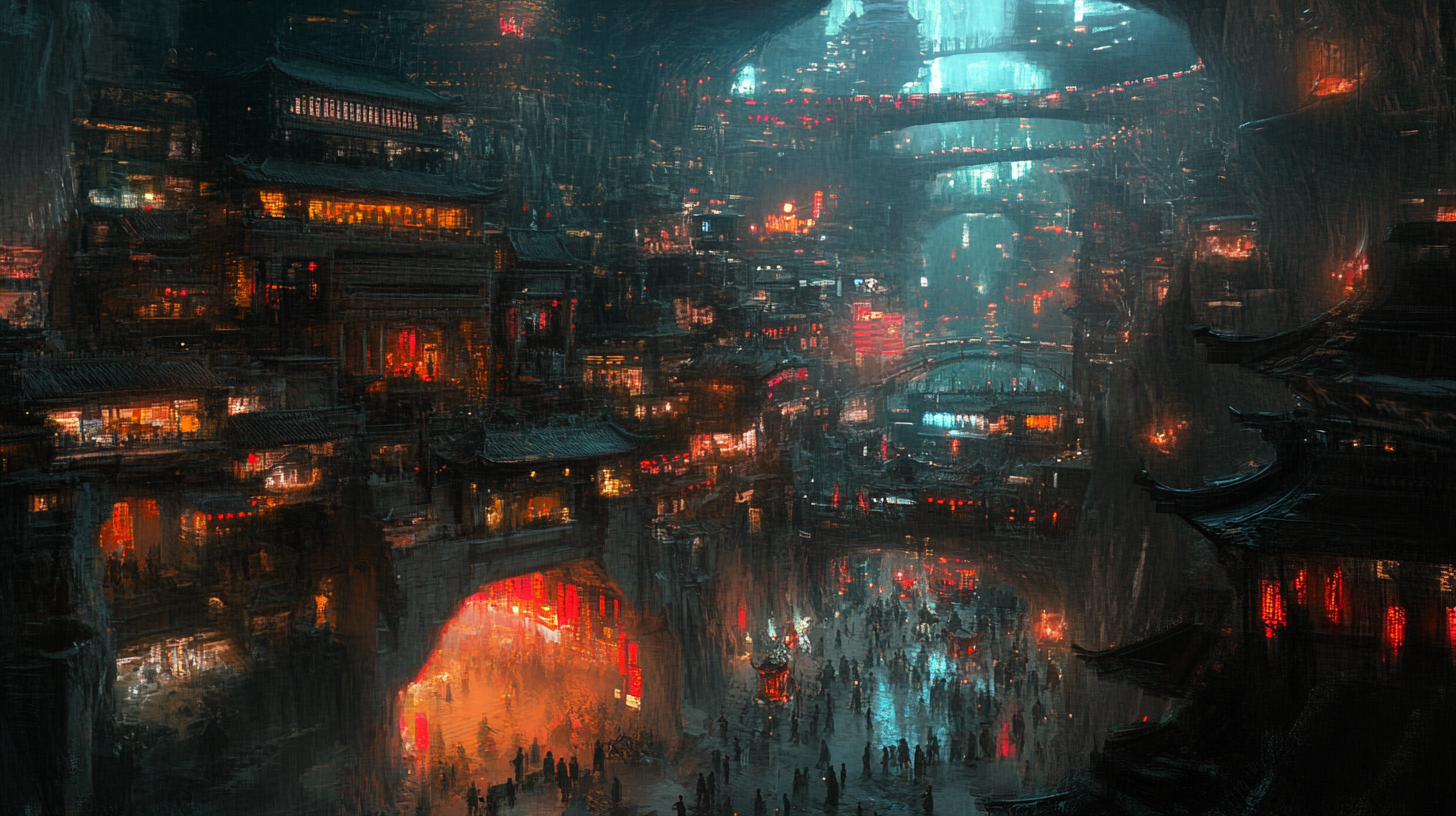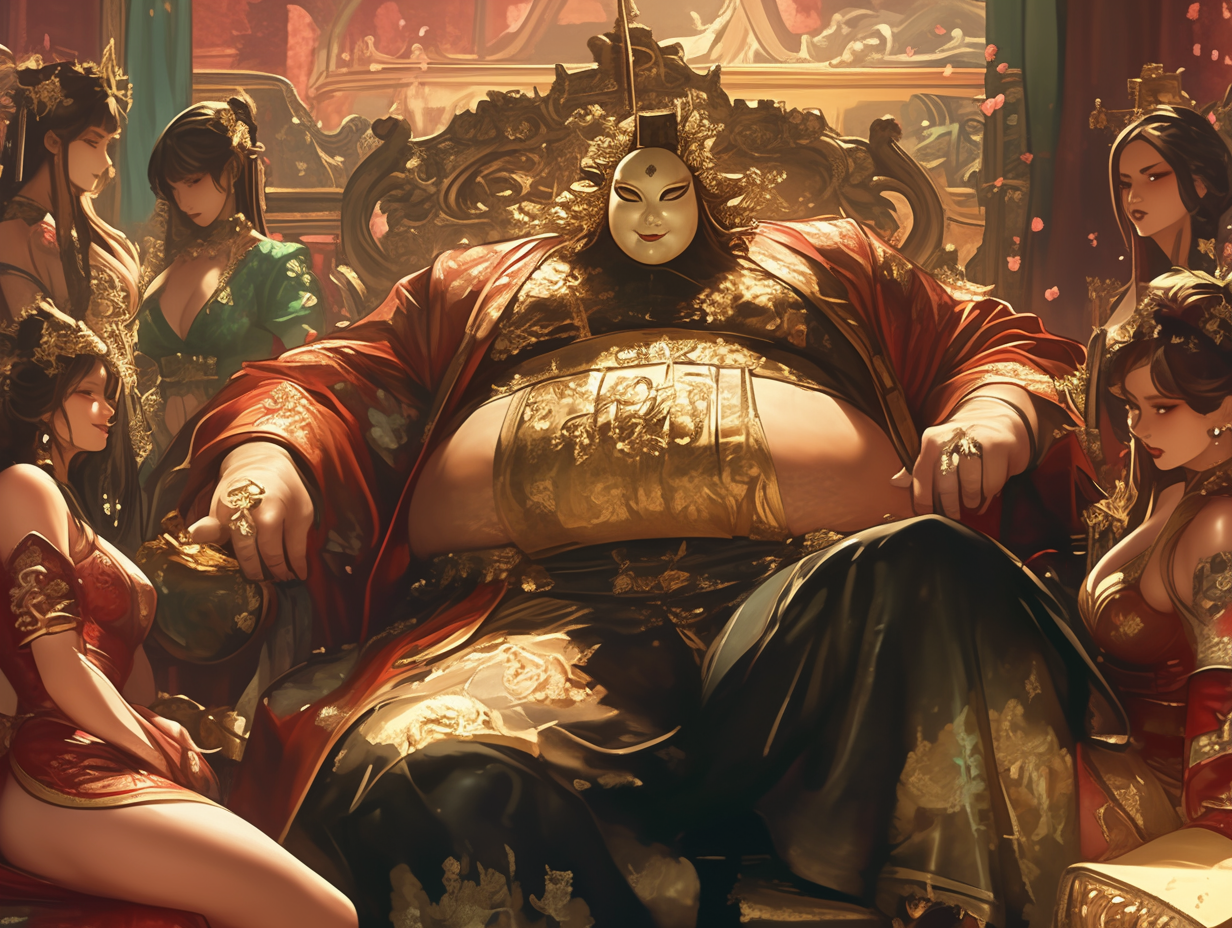Nekrosaka
Deep within the recesses of Legere, the people of Nekrosaka toil to survive. Dim light shines upon streets flanked by towering buildings, bloated with a population that has grown too quickly. Monsters crawl through the lowest and highest levels of the city alike. The steely clash of weapons echoes from within dark alleys.
Nekrosaka was a sprawling subterranean prison-city filled with citizens that had inherited the status of prisoner from long dead ancestors. Situated in the bowels of Legere's subterranean world, Nekrosaka ’s people engaged in a daily battle to feed themselves, fend off monsters, and keep their lights on. It was a dangerous place where enemies were honest and allies traitorous.
Nekrosaka was established as a Songkram prison colony just after the Eastern Civil War. It was built on the western shores of Fereina, just north of The Winding Strait.

History #
Nekrosaka was founded originally as a small Isutan mining colony on Fereina in 200 DHT. It remained relatively small and isolated until around 70 years later, where the Songkram government looked to accelerate its mining operations to fuel the rapid expansion of its military. Nekrosaka was rich in magical crystals, basic metals required to produce Starsteel, and other treasures of the earth. Additionally, Nekrosaka's deepest depths were the home of a massive corpulent structure that Nekrosakans called the Corpse of Niseki.
Seeded with Prisoners #
To populate Nekrosaka with the workers needed to accelerate its mining operations, the Songkram sent prisoners from The Eastern Provinces on Hohm to Nekrosaka. Many of the initial prisoners were Ganpoumi Fi loyalists, critics of the Grand Lord Koh, or others who the Songkram deemed to be too politically antagonistic. After this initial seeding of Nekrosaka by prisoners, the population growth of the city would exponentially increase, causing major infrastructure issues.
Nekrosakan Law #
All Nekrosakans were officially prisoners under Songkram law. A dense spiderweb of technicalities and legalities meant that every citizen born from one or more prisoner parents was also a prisoner of Nekrosaka. Thus, none were free to escape from the oppression of the Bornu.
Bornu Sovereignty #
Following the collapse of the Songkram Empire in 334 DHT (after the Legerian War), Nekrosaka would creep into independence, as the ruling Nekrosakan lords--the Bornu family--took measures to ensure their lordship over the city remained unchallenged and stable. It wouldn't be until the Kenha sought the aid of the Archangel's Heroes that Nekrosaka would be freed from the Bornu's grasp.
Major Locations #
Dailan #
Dailan was the closest of Nekrosaka's urban sprawls to its mines. It was where the poorest of Nekrosakans lived, and those who resided there were frequently slaughtered by the creatures that stalked the mines and the Niseki Caverns.
Deepstar Mines #
The primary mines of Nekrosaka before the discovery of the Corpse of Niseki was the massive network of tunnels known as the Deepstar Mines. As the mines expanded, so did the limits of Nekrosaka.
Lah Ding #
Lah Ding was a small part of Nekrosaka that extended out from the underground and surrounded the Fereinan shores nearest to it. Lah Ding was a primarily military district, rife with Songkram Nakai. After the collapse of the empire, Lah Ding became saturated with new Bornu-loyal nakai.
Lah Ding's purpose was to control the import and export of people and materials. All merchants that came to Nekrosaka--whether Songkram-affiliated or not--had to enter into Lah Ding Port for inspection. Lah Ding was heavily fortified as well, helping it to repel any hostile forces that may have sought to raid the city (or free its prisoner occupants).
Niseki Caverns #
Pherning Cao #
The luxurious Pherning Cao was an opulent and excessively decorated palace built at the highest levels of Nekrosaka. The top of Pherning Cao extended outside to the surface, where the rarely seen majesty of the sun and moon could be gazed upon by the Bornu who lived there.
Access to Pherning Cao Palace was highly limited, with the Bornu rarely leaving it and Nekrosakan commoners being forbidden from entering it. Even Songkram diplomats who arrived to visit Nekrosaka rarely had the opportunity to see the interior of the palace, for if the Grand Lord learned of the prosperity being hogged by the Bornu, taxation would surely increase.
A dedicated wing of Pherning Cao served as a security checkpoint and the sole legitimate accessway to Nekrosaka from the surface (and vice versa).
Nekrosakan Factions #
At the height of its power, Nekrosaka was far from a peaceful city. It was filled with various gangs and criminal organizations, and the civil war between the Kenha and Bornu Nakai never truly cooled.
The Bornu Family #
 The Bornu were a clan of Isutan nobles who once served the Ganpoumi Fi and were awarded lordship over Nekrosaka when it was first established. Nekrosaka promised to be a bountilful land of precious stones and metal, and the Bornu would receive great prosperity from everything mined.
The Bornu were a clan of Isutan nobles who once served the Ganpoumi Fi and were awarded lordship over Nekrosaka when it was first established. Nekrosaka promised to be a bountilful land of precious stones and metal, and the Bornu would receive great prosperity from everything mined.
Following the Eastern Civil War, the Bornu eagerly pledged allegiance to the Songkram Empire, desperate to hold onto the riches their family had accumulated so far. After the Legerian War, the family once again shifted their priorities to ensure that their decadent lifestyles wouldn't be disrupted.
Greed and excessive indulgence, above all else, defined the Bornu. Every action they took was either to revel in their richness or defend their wealth. As ages passed, the Bornu became ugly, fat, and lazy. Each of their days consisted of a schedule jam-packed with orgies and feasting. They masked their horrid, incest-corrupted forms behind lavish costumes, masks, and jewelry. The nakai that served them were clad in bejeweled, gold-trimmed Starsteel, making them gleaming avatars of the Bornu's avaricious ways as they walked Nekrosaka's streets.
The Inbred Lineage
The Bornu were proud of their name and their wealth, and were determined to keep their so-called "honour" within the family. Like certain other ancient royal families across Legere, the Bornu engaged in incestuous relations to maintain their "purity". However, the relentless depravity of the Bornu led to rapid expansion of their family, with each subsequent generation becoming more repulsive than the last.
To fuel their lifestyles, the Bornu claimed ownership over every precious mineral drawn from the earth by any Nekrosakan miner. Such resources were theirs to sell. Using these riches, the Bornu would purchase all sort of commodities from merchants traversing The Winding Strait. The Bornu also frequently had young Nekrosakan women abducted from their families to fuel their ravenous lust. Nekrosakans that took up the challenge of farming within the city's limits also found that any decent-quality produce they managed to raise would be torn from their storehouses and brought straight to the Bornu's tables.
Kenha Rebels #
![[Kenha]]
The Tos Tohn Fellowship #
![[Tos Tohn]]
Local Culture #
Nekrosaka was rife with crime and general lawlessness. The only thing that prevented the city from descending into anarchy were the lithonatomical cyborg monsters that emerged from the [[Corpse of Niseki]], and the ever-growing quotas imposed by The Bornu Family.
Stonemodding #
Stonemodding became widespread in Nekrosaka following its development after the discovery of Nisekite.
Nekrosakan Clans #
Subfactions within Nekrosaka, known as clans, formed as a way for people to form trustworthy bonds. Without a clan at one's back, one was susceptible to swindling, exploitative deals, and knives in the back. Clans ensured that miners and other workers wouldn't be so easily cheated--a slight against a single member of a clan was a slight against them all.
There were hundreds of clans stuffed into Nekrosaka's crowded limits, with the size and power of each varying. The most well-known clan was the Yubokumin.
Runecycling #
![[Runecycles#Races|Runecycle Races]]